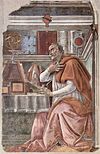Portal:Catholic Church
Introduction The Catholic Church, also known as the Roman Catholic Church, is the largest Christian church, with 1.28 to 1.39 billion baptized Catholics worldwide as of 2024. It is among the world's oldest and largest international institutions and has played a prominent role in the history and development of Western civilization. The church consists of 24 sui iuris churches, including the Latin Church and 23 Eastern Catholic Churches, which comprise almost 3,500 dioceses and eparchies around the world. The pope, who is the bishop of Rome, is the chief pastor of the church. The Diocese of Rome, known as the Holy See, is the central governing authority of the church. The administrative body of the Holy See, the Roman Curia, has its principal offices in Vatican City, which is a small, independent city-state and enclave within the city of Rome, of which the pope is head of state and absolute elective monarch. The core beliefs of Catholicism are found in the Nicene Creed. The Catholic Church teaches that it is the one, holy, catholic and apostolic church founded by Jesus Christ in his Great Commission, that its bishops are the successors of Christ's apostles, and that the pope is the successor to Saint Peter, upon whom primacy was conferred by Jesus Christ. It maintains that it practises the original Christian faith taught by the apostles, preserving the faith infallibly through scripture and sacred tradition as authentically interpreted through the magisterium of the church. The Roman Rite and others of the Latin Church, the Eastern Catholic liturgies, and institutes such as mendicant orders, enclosed monastic orders and third orders reflect a variety of theological and spiritual emphases in the church. Of its seven sacraments, the Eucharist is the principal one, celebrated liturgically in the Mass. The church teaches that through consecration by a priest, the sacrificial bread and wine become the body and blood of Christ. The Virgin Mary is venerated as the Perpetual Virgin, Mother of God, and Queen of Heaven; she is honoured in dogmas and devotions. Catholic social teaching emphasizes voluntary support for the sick, the poor, and the afflicted through the corporal and spiritual works of mercy. The Catholic Church operates tens of thousands of Catholic schools, universities and colleges, hospitals, and orphanages around the world, and is the largest non-government provider of education and health care in the world. Among its other social services are numerous charitable and humanitarian organizations. (Full article...) Selected article
 The papal conclave of 1492 (August 6 – August 11, 1492) convened after the death of Pope Innocent VIII (July 25, 1492), elected Rodrigo Borja as Pope Alexander VI. The first conclave to be held in the Sistine Chapel, the election is notorious for allegations of simony. Of the twenty-three cardinals participating in the conclave, fourteen had been elevated by Pope Sixtus IV. The Cardinals of Sixtus IV, known as the "Sistine Cardinals" and led by Giuliano della Rovere, had controlled the conclave of 1484, electing one of their own, Giambattista Cibo as Pope Innocent VIII. Since 1431 the composition of the College of Cardinals had been radically transformed, increasing the number of cardinal-nephews (from 3 to 10), crown-cardinals (from 2 to 8), and representatives of powerful Roman noble families (from 2 to 4). With the exception of three curial officials and one pastor, the cardinals were "secularly-minded princes largely unconcerned with the spiritual life of either the Latin church or its members." At the time of Innocent VIII's death, the names of Cardinals Gherardo and Sanseverino had not been published, thus making them ineligible to participate in the conclave; however, both were published as an act of the College in sede vacante, Gherardo having been pushed by Orsini and Sanseverino by Sforza.
Selected image
 Credit: Leonardo da Vinci Leonardo da Vinci's cartoon The Virgin and Child with St Anne and St John the Baptist combines two themes popular in Florentine painting of the 15th century: the Virgin and Child with St John the Baptist and the Virgin and Child with St Anne. Selected biography
 Mother Teresa (Albanian: Agnes Gonxha Bojaxhiu; Albanian pronunciation: [ˈaɡnɛs ˈɡɔndʒa bɔˈjadʒu]) (August 26, 1910 – September 5, 1997) was an Albanian Roman Catholic nun who founded the Missionaries of Charity in Kolkata (Calcutta), India in 1950. For over forty years she ministered to the poor, sick, orphaned, and dying, while guiding the Missionaries of Charity's expansion, first throughout India and then in other countries. By the 1970s she had become internationally famed as a humanitarian and advocate for the poor and helpless, due in part to a documentary, and book, Something Beautiful for God by Malcolm Muggeridge. She won the Nobel Peace Prize in 1979 for her humanitarian work. Mother Teresa's Missionaries of Charity continued to expand, and at the time of her death it was operating 610 missions in 123 countries, including hospices and homes for people with HIV/AIDS, leprosy and tuberculosis, soup kitchens, children's and family counseling programs, orphanages, and schools.
Did you know...

Related portalsFeast Day of February 3
Blaise is a saint in the Catholic, Western Rite Orthodoxy, Eastern Orthodox and Oriental Orthodox Churches and is the patron saint of wool combers and of sufferers from ENT illnesses. In the Latin Church, his feast falls on 3 February. In the Eastern Churches, it is on 11 February. According to the Acta Sanctorum, he was martyred by being beaten, tortured with iron combs, and beheaded. (Full article...) Selected quote

News
SubcategoriesTopics
The Holy Bible:
Particular Churches (grouped by liturgical rite):
Things you can do
External resourcesWikiProjectsAssociated WikimediaThe following Wikimedia Foundation sister projects provide more on this subject:
Discover Wikipedia using portals |

































